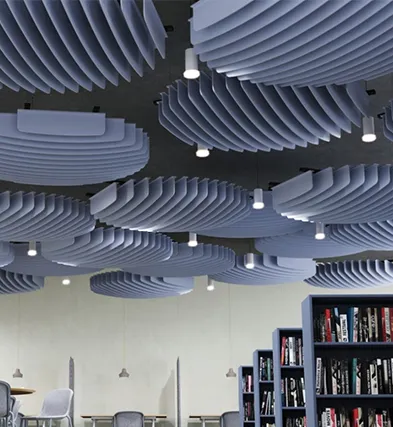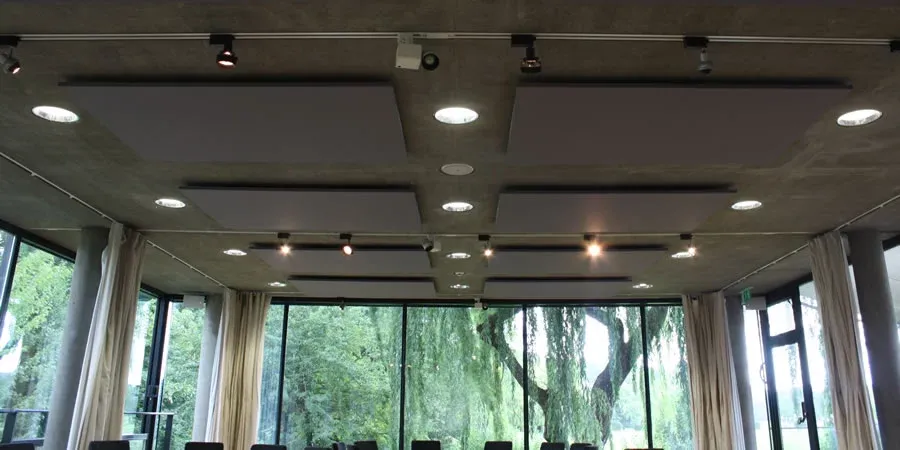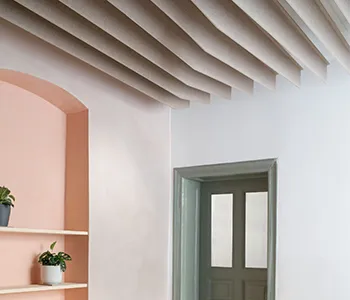Evite que su consulta sea de respuesta tardía, por favor introduzca su WhatsApp/Skype junto con el mensaje, para que podamos ponernos en contacto con usted a la primera.
Le responderemos en un plazo de 24 horas. Si para el caso urgente, por favor agregue WhatsApp/WeChat: +86-13678899682 directamente.
Noisy rooms make people strain to hear. Echo builds, voices blur, and meetings stall. That’s the problem. Agitate: sound waves bounce off hard techo surfaces and multiply. The solution: smart tratamiento acústico overhead that cuts reverberación and boosts clarity—without wrecking your design.
The best tratamiento acústico para ceilings depends on your space and goals. For rapid retrofit, use techo acústico clouds or ceiling baffles a absorber el sonido. For clean, continuous looks, choose placas acústicas para techos systems in a suspended ceiling. For premium finishes, wood or PET ceiling panels combine design with high NRC ratings. Pick based on target RT60, budget, fire rating (ASTM E84), and installation method.

acoustic ceiling treatment panels
Somos un fabricante profesional en China especializado en PET de alta calidad y madera paneles acústicos, offering OEM/ODM customization for global B2B projects. Our factory supports architects, distributors, importers, contractors, and brand owners with consistent quality, documentation, and fast delivery.
Hard techo planes behave like mirrors for sound. When a person speaks, each onda sonora hits the techo, walls, and floor, then returns. In untreated rooms, those reflections layer into eco y reverberación. People struggle to hear, and speech becomes tiring.
Acoustics in a space improve when we add materials made from porous materials that let air molecules vibrate inside tiny pores, turning sound energy into heat. That process is absorción acústica (also called absorción). When you add enough materials in a room with proper coverage, you improve the acoustic comfort and clarity.
Quick definition: RT60 (reverberation time) is how long a room takes to decay by 60 dB after a sound stops; it’s a key metric for room’s acoustics and design.
There are multiple types of acústico products for ceilings:
Clouds are designed to reduce reflections in open areas, while baffles help in rooms with high or long high ceilings and where sprinklers/ducts require air movement. Acústica clouds are horizontal; baffles are vertical—this orientation difference affects performance and aesthetics.

Acoustic ceiling panels (direct-mount)
If your building already uses a grid, acoustic ceiling tiles are made for speed and uniformity. Typical tiles use mineral fiber, PET felt, or fiberglass. Estos tiles are designed to drop into T-bar grids for easy installation, consistent plenum access, and integrated lighting/HVAC. A suspended ceiling lets you install acoustic ceiling panels fast across large areas, even during retrofit.
For safety, look for ASTM E84 flame spread/smoke development documentation (Class A/B) and check fire-rated options where the code requires it.
Use this simple path to solve your acoustic challenges:

How to choose the right acoustic treatment
NRC (Noise Reduction Coefficient) rates how much a product absorbs at speech frequencies (0.0–1.0+). NRC is derived from lab tests (e.g., ASTM C423) and gives you a fast way to compare absorbers. Acoustical designers then model reverberation time (RT60) using room volume and equivalent absorption.
Rule of thumb table
| Ceiling option | Typical composition | Typical NRC range | Best for |
|---|---|---|---|
| Direct-mount paneles acústicos para techos | PET felt, rigid fiberglass backing, or recycled cotton | 0.70–0.95 | Simple ceiling treatment in offices, corridors |
| Nubes de techo | PET/wood veneer over absorber | 0.80–1.00 | Open plans, spaces like restaurants |
| Ceiling baffles | PET or fiberglass blades | 0.85–1.10 | Rooms with high or exposed ceilings |
| Plafón acústico (T-grid) | Mineral fiber, PET, fiberglass | 0.55–0.90 | Uniform coverage, quick retrofit |
Sabine equation (quick view): RT60 ≈ 0.049 × Volume / Total Absorption (sabins). Add panels to raise total sabins and lower RT60.
Great acústico design should look intentional. PET felt and wood-veneer ceiling panels come in discs, rectangles, or slats. Ceiling clouds come in custom shapes—logo silhouettes or wayfinding arrows—and are available in a wide range of color options to match brand palettes. Use slatted wood for warmth and PET for bold colors; mix both acoustically for a tailored look.
Diffuser panels (often wood) scatter sound instead of absorbing it. In multipurpose halls, combine absorption with diffuser panels to keep liveliness while controlling echoes. Balance by frequency: lower frequencies (longer wavelength) need depth and sometimes bass traps at edges, while speech bands benefit most from overhead acústico absorption.
There are different ways to install ceiling treatments:
Tip: Always verify sprinkler clearance and lighting layouts before install. Our engineering team shares shop drawings, load data, and ASTM/nrc documentation to streamline approvals.
Remember, treatments come in many densities and thicknesses, each designed to reduce reflections differently. For low-frequency issues, add bass traps at perimeter soffits.
1) Open-plan office, 3.5 m high
Problem: Calls collide; people struggle to hear near collaboration zones.
Solution: 30% ceiling coverage using PET nubes de techo and a few rows of ceiling baffles over corridors. Result: RT60 dropped from 1.2 s to ~0.5 s and mejorar el sonido quality for speech.
2) Classroom with high ceilings
Problem: Speech clarity and teacher fatigue.
Solution: Direct-mount paneles acústicos para techos over front third of the room plus wall acústico strips. Target achieved: ≤0.6–0.7 s RT60 per school guidance.
3) Restaurant with concrete ceiling
Problem: Buzz and distorted sounds at peak hours.
Solution: Mixed paneles de nubes and wood slat acústico absorbers; kept branding with custom shapes and color options. Guests reported better calidad de sonido.
Specifiers often ask for ASTM E84 reports. This lab test rates surface burning (Flame Spread/Smoke Developed) to help AHJs classify products (Class A/B/C). It’s distinct from overall assembly ratings, but remains the go-to for finish materials like techo acústico products. Ask vendors for current reports and mounting descriptions.
Absorber effectiveness (NRC bands, relative)
Clouds/Baffles | ██████████
Direct-mount PET | ████████
Grid Tiles (mid) | ██████
Wood Slat + Fleece| ███████
NRC is a convenient one-number summary of acústico absorption at speech bands; always review detailed data when critical.
What’s the difference between soundproof and sound-absorbing?
"Insonorización” means blocking transmission through a partition (STC). Absorbers like techo acústico productos absorber el sonido inside the room to reduce reverberación y improve the acoustic clarity. Use barriers to block; use absorbers to tame reflections. (See also NRC vs. STC notes.)
Can I mix clouds, baffles, and tiles?
Yes. Use tiles for broad coverage, add clouds over collaboration zones, and baffles in long corridors. This layered approach treats acoustics in your space effectively and keeps design flexible.
How many panels do I need?
Aim for the RT60 target. Use the Sabine method to estimate coverage, then add or subtract area until the model hits your goal. Our team can lugar acústico products and model results for you.
Are acoustic ceiling tiles DIY-friendly?
Drop-in placas acústicas para techos systems are straightforward for skilled trades. For direct-mount panels, verify substrate and fastener types. Always coordinate with MEP for sprinklers and lights, and install acoustic ceiling products per drawings.
What are tiles made of—and are they safe?
Commonly mineral fiber, PET felt, or fiberglass. Request ASTM E84 data and consider low-VOC certifications as needed. Las placas acústicas para techos se fabrican to be designed to reduce reflected sound and meet code expectations.
Do I need bass traps on the ceiling?
If you have low-frequency build-up, add edge bass traps or thicker absorbers at boundaries. Most offices focus on speech clarity, so standard ceiling absorbers handle mid-band issues; studios need more for lower frequencies.
You’ve seen different acoustic options for the techo—paneles acústicos para techos, nubes de techo, ceiling bafflesy placas acústicas para techos grids. In most commercial spaces, a blended approach is a great option to consider: tiles for coverage, clouds above collaboration, and baffles in circulation. With the right mix, you mejorar el sonido fast—often without touching the floor plan.
As an OEM/ODM factory, we make PET and wood systems designed to be installed quickly with easy installation hardware. We support submittals, ASTM reports, mockups, and project branding. If you’re a distributor, architect, contractor, or a brand owner, we can install acoustic ceiling panels in your spec set—custom sizes, edges, and finishes—so you can choose the right acoustic path and solve your acoustic challenges on schedule and budget.